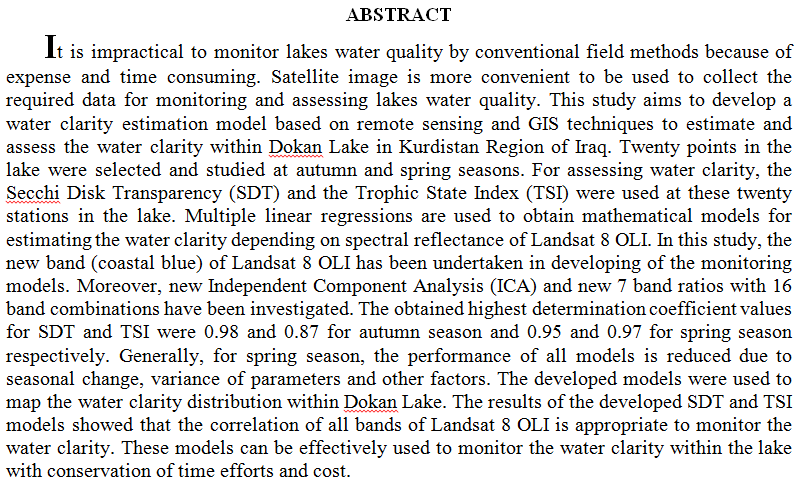
This study examined the effects of water scarcity on rural household economy in El Fashir Rural Council / North Darfur State- western Sudan. Both quantitative and qualitative methods were used as to get a deeper understanding of the impact of water scarcity on the rural house economy in the study area. 174 households out of 2017 were selected from 45 villages which were distributed in eight village councils forming the study area. Statistical methods were used to manipulate the data of the study. The obtained results revealed that water scarcity negatively affected the rural household economy in the study area in many features. These include the followings: much family efforts and time were directed to fetch for water consequentl
... Show More (1)
(1)
In this study, we fabricated nanofiltration membranes using the electrospinning technique, employing pure PAN and a mixed matrix of PAN/HPMC. The PAN nanofibrous membranes with a concentration of 13wt% were prepared and blended with different concentrations of HPMC in the solvent N, N-Dimethylformamide (DMF). We conducted a comprehensive analysis of these membranes' surface morphology, chemical composition, wettability, and porosity and compared the results. The findings indicated that the inclusion of HPMC in the PAN membranes led to a reduction in surface porosity and fiber size. The contact angle decreased, indicating increased surface hydrophilicity, which can enhance flux and reduce fouling tendencies. Subsequently, we evaluated the e
... Show MoreFormation of emulsions during oil production is a costly problem, and decreased water content in emulsions leads to increases productivity and reduces the potential for pipeline corrosion and equipment used. The chemical demulsification process of crude oil emulsions is one of the methods used for reducing water content. The demulsifier presence causes the film layer between water droplets and the crude oil emulsion that to become unstable, leading to the accelerated of water coalescence. This research was performed to study the performance of a chemical demulsifier Chimec2439 (commercial) a blend of non-ionic oil-soluble surfactants. The crude oils used in these experiments were Basrah and Kirkuk Iraqi crude oil. These
... Show More (7)
(7)
Abstract. Shock chlorination is a well-known practice in swimming pools and domestic wells. One of the limitations for using this technique in drinking water purification facilities is the difficulty of quickly removing high chlorine concentrations in water distribution systems or production facilities. In order to use this method in the drinking water industry a shock de-chlorination method should be introduced for producing microorganism and biocide free water. De-chlorination using natural stagnant aeration (leaving the water to lose the chlorine naturally) is the safest known method if compared with chemical and charcoaling methods. Unfortunately, stagnant aeration is a slow process. Therefore, developing a process for accelerat
... Show More (4)
(4)
Water Quality Index (WQI) as a tool to assess the water quality status provides advice related to the use of water quality monitoring data and it is a way for combining the complex water quality data into a single value or single statement.The present study was conducted on Al- Hilla river in the middle of Iraq from August 2012 to July 2013 at five selected stations in the river, from Al- Musaib city to Al- Hashimya at the south of Hilla to determine its suitability for aquatic environment (GWQI), drinking water (PWSI) and irrigation (IWQI).This index offers a useful representation of the overall quality of water for public or any intended use as well as indicating pollution, water quality management, and decision making. According to th
... Show More (9)
(9)
 (1)
(1)
The body has the ability to effect the audience in the the theatrical show , since he or she is transmitter , sender , seen and viewer of the humanitarian discourse as well the the images and connotations of the theatrical show, it is a tool of communication that substitutes for millions of spoken words, the modern schools of direction focused on the body language of the actor and gave it prominence in depicting facts by different connotations. The researcher studies the physical performance of the actor throughout focusing on the connotational dimensions of the body within the theatrical show , as well as the positioning of performative body within the modern schools of direction depending on the theatrical show (Rebuke ) of the Iraqi d
... Show MoreDue to the deterioration of water quality within the last few years because of the increase of water consumption and the waste water production and disposal into the river The water quality in both surface and ground water resources was negatively affected .The concept of water quality index is used as a tool for water quality classification in Tigris River within Baghdad City .Twenty two parameters of pollution were selected to measure the water quality indices of Tigris river within Baghdad city .Those parameters were measured during (2000-2004)as average monthly values ,three water treatment plants were selected out of the eight water treatment plants that exist along the river.Al Kharkh water treatment plant to reflect the water quality
... Show More (6)
(6)
This research deals with the fact that arts exit from their familiar context in practice and enter in the context of the fantasy and exoticism picture. In order to understand the theatrical phenomenon and know the way of its production of the fantasy picture, especially the acting performance in its transitions between the real and fantasy. This study consists of: an introduction of the research in which the researcher presented the research problem, importance and objectives.
The theoretical framework dealt with founding a theoretical part for the research consisting of two sections: the first (fantasy: the concept and the working) and the second (techniques of acting perfo
... Show More
